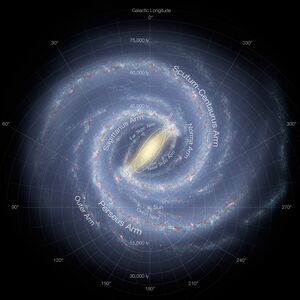علم الفلك المجري
علم الفلك المجري Galactic astronomy هو دراسة مجرة درب التبانة أو (الطريق اللبني) التي نسكن فيها، بعكس علم الفلك خارج المجري الذي يدرس كل ما هو خارج مجرتنا بما في ذلك المجرات الأخرى.
يجب أن لا يخلط بين علم الفلك المجري و علم تشكل و تطور المجرات وهو الدراسة العامة للمجرات وتشكلها وبنيتها ومكوناتها وحركياتها وتآثراتها ومجال الأشكال التي تأخذها.
مجرة درب التبانة، التي ينتمي لها نظامنا الشمسي هي من أكثر المجرات دراسة حتى الآن مع إن الأجزاء المهمة منها لا يمكن رصدها ضمن مجال اطوال الموجات المرئية فهي محجوبة بمناطق من الغبار المجري. لكن تطور علم الفلك الراديوي علم الفلك تحت المليمتري submillimeter astronomy في القرن العشرين سمح للغاز والغبار في درب التبانة بأن يحدد ضمن خريطة للمرة الأولى.
وفي أي ليلة صافية يمكن أن ترى عبر الفضاء من طرف إلى آخر خصلة من الضوء مكفهرة، أكثر إتساعاً في بعض الأمكنة منها في الأمكنة الأخرى. إن رؤية هذه الخصلة ممكنة من كل مناطق العالم سواء للشمال أو للجنوب من خط الاستواء ولذلك لابد إنها تمتد عبر الفضاء بكامله، وقد دعاها علماء الفلك الأقدمون سكة اللبن أو درب التبانة، لإنهم أعتقدوا إنها كما تبدو مجرى حليبياً عبر الفضاء، أو طريق للتبانة، وأشتقوا لها إسما من أصل يوناني يعني اللبن، لكن أحدا لم يعرف هذه الخصلة ومواصفاتها قبل أن صنع غاليلو مرقبهُ الأول. عند ذاك تمكن غاليلو أن يكتشف إنها تتألف من الملايين من النجوم المنفصلة.
ومجرة درب التبانة أكثر تألقاً في بعض أقسامها مما هي عليه في أقسام أخرى. فالقسم الذي يحيط بكوكبة الدجاجة شديد اللمعان، ولكن القسم الأكثر إتساعاً ولمعاناً يقع أبعد إلى الجنوب في كوكبة القوس، ورؤيتها ممكنة في الفضاء الشمالي على إنخفاض كبير في الأمسيات الصيفية، لكن مشاهدتها أكثر سهولة في البلدان الواقعة للجنوب من خط الاستواء.
Subcategories
A standard set of subcategories is used by astronomical journals to split up the subject of Galactic Astronomy:[1][بحاجة لمصدر]
- abundances – the study of the location of elements heavier than helium
- bulge – the study of the bulge around the center of the Milky Way
- center – the study of the central region of the Milky Way
- disk – the study of the Milky Way disk (the plane upon which most galactic objects are aligned)
- evolution – the evolution of the Milky Way
- formation – the formation of the Milky Way
- fundamental parameters – the fundamental parameters of the Milky Way (mass, size etc.)
- globular cluster – globular clusters within the Milky Way
- halo – the large halo around the Milky Way
- kinematics, and dynamics – the motions of stars and clusters
- nucleus – the region around the black hole at the center of the Milky Way (Sagittarius A*)
- open clusters and associations – open clusters and associations of stars
- Solar neighborhood – nearby stars
- stellar content – numbers and types of stars in the Milky Way
- structure – the structure (spiral arms etc.)
Stellar populations
Interstellar medium
- Interplanetary space - Interplanetary medium - interplanetary dust
- Interstellar space - Interstellar medium - interstellar dust
- Intergalactic space - Intergalactic medium - Intergalactic dust
انظر أيضاً
المراجع
- ^ "Galactic Astronomy - Subcategories | The English knowledge database". science-train.com (in الإنجليزية). Archived from the original on 2017-12-22. Retrieved 2017-12-20.
مصادر
وصلات خارجية
- Mapping the hydrogen gas in the Milky Way
- Mapping the dust in the centre of the Milky Way
- Search for Astronomy
